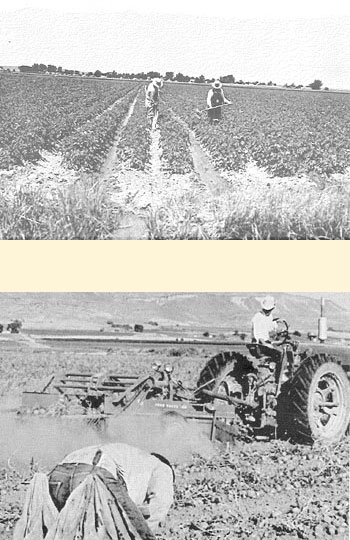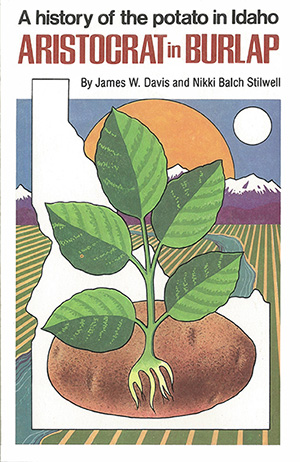CAREY LAND ACT TRANSFORMS DESERT INTO POTATO FIELDS
 (Top)-Early potato land had to be flat enough for gravity irrigation.
(Bottom)-Hand potato picking after tractors replaced horses for digging.
(Top)-Early potato land had to be flat enough for gravity irrigation.
(Bottom)-Hand potato picking after tractors replaced horses for digging.
The other factor in the failure of the Carey Act was the almost total lack of information as to the available water supply for a particular undertaking. The irrigation engineer was unknown, and comprehensive knowledge of stream flow and annual runoff was almost nonexistent.
According to Mikel Williams, the main problems encountered in the operation and administration of the Carey Act, lack of funds and water, were not inherent defects in the Carey Act itself, but rather the result of poor planning and lack of adequate information.
The most successful and famous Carey Act project was the Twin Falls South Side Project located in Twin Falls and Cassia Counties. The estimated cost of the project was $1,500,000, but the final cost amounted to $3,600,000.
The original proposal was filed in October of 1900 by a group of wealthy financiers from Pittsburgh, Pennsylvania, who had plans for reclaiming some 250,000 acres of land. By 1932, the project was operating efficiently except for some seepage problems and some reconstruction on the Milner Dam. At that time, 192,750 acres had been reclaimed. From the standpoint of the settlers, the construction company and the state, the project was termed a success. The most important contribution of the Twin Falls South Side Project was that it proved that reclamation was feasible on a wide scale. Only one mortgage was given by the construction company and it was soon paid off. The success of this project spurred new Carey Act developments in the state and with them came money and people.
The success of the South Side Project was a definite incentive for developers of new projects. Two of the most ambitious promoters were the Kuhn brothers from Pittsburgh. In approximately 15 months, the Kuhns started three Carey Act projects and segregated 199,552 acres of desert land. Each of their projects adopted the name "Twin Falls" in an effort to trade on the reputation of their earlier success.
None of the Kuhn-sponsored projects developed as well as the original Twin Falls project did. Of the three, the Twin Falls North Side Project had the greatest success with patent acres at 178,062.17 after many problems and only a reduction of 85,000 acres from the segregated acreage.


 (Top)-Early potato land had to be flat enough for gravity irrigation.
(Bottom)-Hand potato picking after tractors replaced horses for digging.
(Top)-Early potato land had to be flat enough for gravity irrigation.
(Bottom)-Hand potato picking after tractors replaced horses for digging.